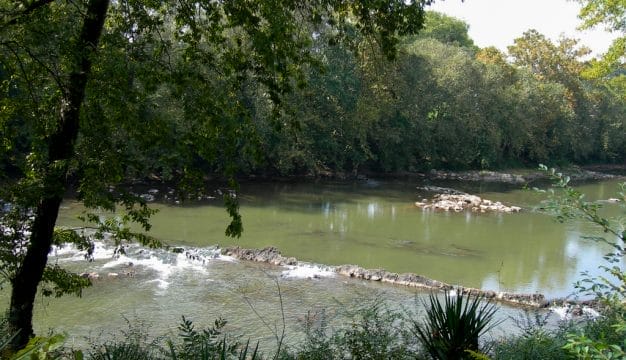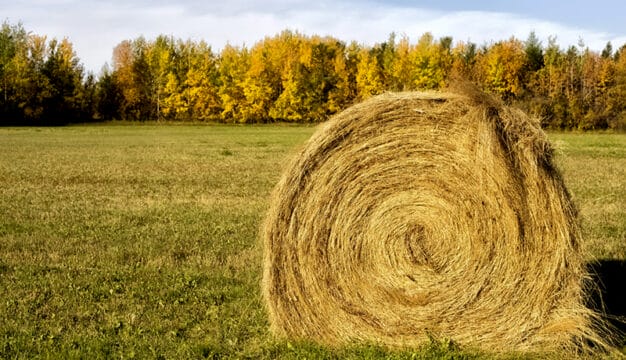Cave Pseudoscorpions
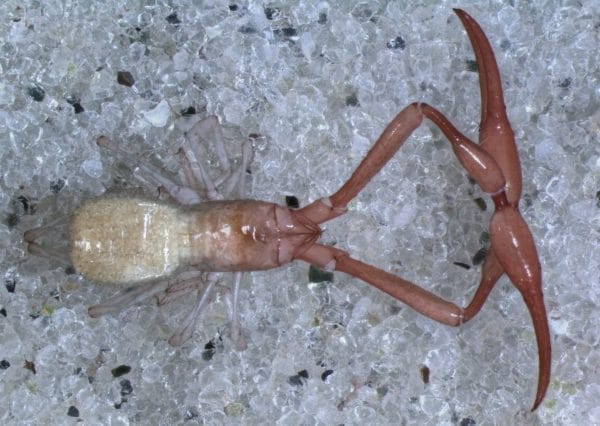 Cave Pseudoscorpion
Cave pseudoscorpions are predatory arthropods, like spiders and true scorpions, and are found widely in Alabama‘s extensive cave systems, especially in the northeastern region of Jackson, Madison, and Marshall Counties. Presently, 46 species of cave pseudoscorpions have been described in Alabama. Forty of these are “endemic” (found nowhere else in the world), and altogether cave pseudoscorpions make up approximately one-third of all known cave animals in Alabama. The Alabama Natural Heritage Program, which keeps track of Alabama’s rare and threatened plants and animals and assigns them conservation ranks, lists 40 cave pseudoscorpion species as “imperiled,” and all are threatened to some degree. Ongoing research has discovered species not currently being tracked: these include four described species and as many as 30 potential new species.
Cave Pseudoscorpion
Cave pseudoscorpions are predatory arthropods, like spiders and true scorpions, and are found widely in Alabama‘s extensive cave systems, especially in the northeastern region of Jackson, Madison, and Marshall Counties. Presently, 46 species of cave pseudoscorpions have been described in Alabama. Forty of these are “endemic” (found nowhere else in the world), and altogether cave pseudoscorpions make up approximately one-third of all known cave animals in Alabama. The Alabama Natural Heritage Program, which keeps track of Alabama’s rare and threatened plants and animals and assigns them conservation ranks, lists 40 cave pseudoscorpion species as “imperiled,” and all are threatened to some degree. Ongoing research has discovered species not currently being tracked: these include four described species and as many as 30 potential new species.
Pseudoscorpions are classified into the order Pseudoscorpiones, of the class Arachnida, in the phylum Arthropoda. Their closest relatives are not scorpions (order Scorpiones), however, but camel spiders (order Solifugae). Another common name for pseudoscorpions is book scorpions because some species are found in libraries, where they prey on insect pests that eat paper. There are almost 30 families of pseudoscorpions totaling some 3,500 species worldwide, but at present only three families are known from Alabama’s caves: the Chernetidae, Chthoniidae and Neobisiidae. Alabama’s caves hold one cave species from family Chernetidae, 35 from family Chthoniidae, and 10 from family Neobisiidae. Many species are known from just one cave. For example, the species Tyrannochthonius aladdinensis is found only in Aladdin Cave in Madison County.
Pseudoscorpions range in size from 0.08 to 0.31 inches (2 to 8 millimeters), with the largest, a species from Ascension Island in the southern Atlantic Ocean, being a half inch (12 millimeters) long. All pseudoscorpions in Alabama, including cave species, are less than one centimeter long, and their general appearance is that of a tiny tailless scorpion. Their small size and shape sometimes makes them seem similar to ticks or chiggers, but they are only distant cousins to these arachnids.
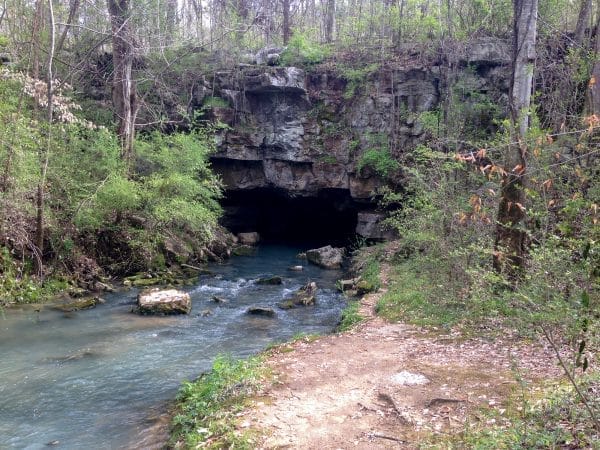 Hering Cave Entrance
Like all arachnids and some related arthropods, pseudoscorpions have a body divided into two sections, eight pairs of legs used for walking, and two specialized appendages at the front of the body called pedipalps and chelicerae. In pseudoscorpions, the pedipalps have evolved into large claws that are used to capture prey, and it is these that give them their resemblance to true scorpions. The chelicerae are much smaller claw-like appendages that are used to direct food to the mouth and sometimes to hold prey. Similarly to spiders, they digest their prey externally through regurgitating digestive enzymes from their mouth onto their prey that then dissolve the prey’s tissues into a soup-like consistency. Uniquely in pseudoscorpions, the chelicerae have silk-spinning glands that are used to weave protective silken nests when a pseudoscorpion is preparing to molt.
Hering Cave Entrance
Like all arachnids and some related arthropods, pseudoscorpions have a body divided into two sections, eight pairs of legs used for walking, and two specialized appendages at the front of the body called pedipalps and chelicerae. In pseudoscorpions, the pedipalps have evolved into large claws that are used to capture prey, and it is these that give them their resemblance to true scorpions. The chelicerae are much smaller claw-like appendages that are used to direct food to the mouth and sometimes to hold prey. Similarly to spiders, they digest their prey externally through regurgitating digestive enzymes from their mouth onto their prey that then dissolve the prey’s tissues into a soup-like consistency. Uniquely in pseudoscorpions, the chelicerae have silk-spinning glands that are used to weave protective silken nests when a pseudoscorpion is preparing to molt.
Typically, pseudoscorpions are brownish or yellowish, but cave-adapted pseudoscorpions are pale or entirely white with a translucent exoskeleton. Compared to their above-ground relatives, cave pseudoscorpions are larger overall, are covered with longer sensory hairs, and have longer legs and longer specialized appendages. Additionally, rather than the typical two pairs of eyes found in terrestrial pseudoscorpions, the below-ground types have only one pair or have no eyes at all. These adaptations have provided cave pseudoscorpions an advantage in locating and capturing prey in the complete darkness of the subterranean environment. In caves, they are generally found under debris or in small rock fissures near sources of prey, which are the insects and mites that congregate around animal droppings and other organic debris washed underground.
There are some differences in the physiology and the size and proportions of pseudoscorpions in different families. Those in family Chthoniidae are non-venomous, and their pedipalp claws are long and scissor-like, with long spiney teeth to ensnare soft-bodied prey. The chelicerae of Chthoniidae are relatively large and muscular and are used along with the pedipalps to capture prey. All pseudoscorpions in the family Neobisiidae are venomous, and they have large, muscular pedipalps with long teeth that are used to ensnare and hold prey while they inject venom through specialized teeth on the tips of the pedipalps. Their venom is highly effective against the small insects and mites they prey upon but is not known to have any effect on vertebrates such as humans. Chelicerae in Neobisiidae are relatively weak compared to those in Chthoniidae and do not appear to be used in capturing prey. One genus of Neobisiidae is named after Alabama, Alabamocreagris, and includes two species, Alabamocreagris mortis and Alabamocreagris pecki, both of which are endemic to the state. Similarly to Neobisiidae, pseudoscorpions in family Chernetidae are venomous, but their pedipalps are more muscular and the teeth on them tend to be much shorter. Chelicerae in Chernetidae are very small and only appear to be used for directing food to the mouth and spinning silk nests.
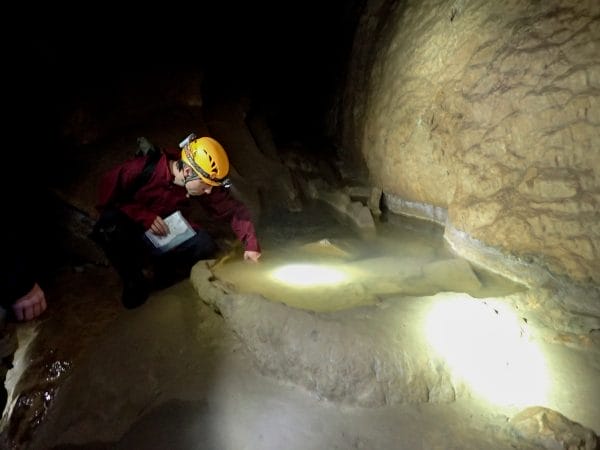 Tumbling Rock Cave
Ongoing research is uncovering ever more new types of creatures in Alabama’s caves. One example is a probably new species of pseudoscorpion from family Neobisiidae discovered in 2016 in Tumbling Rock Cave in Jackson County. Scientists have also discovered additional species in the family Chernetidae. Currently only one species in this family is known from an Alabama cave, Parachernes virginicus, but it may have accidentally ended up in a cave as it is not strongly cave-adapted. East of the Mississippi River, two cave-adapted species in one genus are known from this family of venomous pseudoscorpions. One species, Hesperochernes mirabilis, has been found in caves ranging from northern Alabama to Ohio; the other is restricted to two caves in Indiana. Hesperochernes mirabilis is often found crawling in the nests of pack rats (Neotoma sp.) or in bat guano, where it hunts parasites of these rodents and guano-feeding mites. Current research is using molecular data to explore whether the species Hesperochernes mirabilis is truly one species or in fact several similar-looking but distinct species.
Tumbling Rock Cave
Ongoing research is uncovering ever more new types of creatures in Alabama’s caves. One example is a probably new species of pseudoscorpion from family Neobisiidae discovered in 2016 in Tumbling Rock Cave in Jackson County. Scientists have also discovered additional species in the family Chernetidae. Currently only one species in this family is known from an Alabama cave, Parachernes virginicus, but it may have accidentally ended up in a cave as it is not strongly cave-adapted. East of the Mississippi River, two cave-adapted species in one genus are known from this family of venomous pseudoscorpions. One species, Hesperochernes mirabilis, has been found in caves ranging from northern Alabama to Ohio; the other is restricted to two caves in Indiana. Hesperochernes mirabilis is often found crawling in the nests of pack rats (Neotoma sp.) or in bat guano, where it hunts parasites of these rodents and guano-feeding mites. Current research is using molecular data to explore whether the species Hesperochernes mirabilis is truly one species or in fact several similar-looking but distinct species.
Like all cave-dwelling animals, cave pseudoscorpions are highly vulnerable to human activity. Many species are found in only one cave thus face a heightened risk of extinction. All cave pseudoscorpion species listed by the Alabama Natural Heritage Program are considered “imperiled.” Human activities such as dumping trash into caves or spray-painting graffiti or arrows to point the way out of a cave have the potential to leach toxic chemicals into the fragile cave ecosystem. Although these activities can seem harmless in what appears to be a lifeless cave, they have the potential to put entire species only known from that one cave at risk of extinction.
Further Reading
- Alabama Natural Heritage Program. Alabama Inventory List: The Rare, Threatened and Endangered Plants & Animals of Alabama. Auburn, Ala.: Auburn University Museum of Natural History, 2016.
- Niemiller, Matthew L., Kirk S. Zigler, and Danté B. Fenolio. Cave Life of TAG: A Guide to Commonly Encountered Species in Tennessee, Alabama and Georgia. Huntsville, Ala.: National Speleological Society, 2013.

